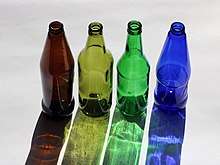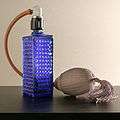Glass bottle
A glass bottle is a bottle made from glass. Glass bottles can vary in size considerably, but are most commonly found in sizes ranging between about 200 millilitres and 1.5 litres. Common uses for glass bottles include food condiments, soda, liquor, cosmetics, pickling and preservatives. These types of bottles are utilitarian and serve a purpose in commercial industries.

History
_(cropped).jpg)
Glass bottles and glass jars are in many households around the world. The first glass bottles were produced in south east Asia around 100 B.C., and in the Roman Empire around 1 AD.[1] America's glass bottle and glass jar industry was born in the early 1600s, when settlers in Jamestown built the first glass-melting furnace. The invention of the automatic glass bottle blowing machine in 1880 industrialized the process of making bottles.[2]
In 2019, plans were made to re-introduce milk glass bottle deliveries to Auckland in early 2020.[3]
Manufacture
The earliest bottles or vessels were made by ancient man. Ingredients were melted to make glass and then clay forms were dipped into the molten liquid. When the glass cooled off, the clay was chipped out of the inside leaving just the hollow glass vessel.[4] This glass was very thin as the fire was not as hot as modern day furnaces. The blowpipe was invented around 1 B.C. This allowed molten glass to be gathered on the end of the blow pipe and blown into the other end to create a hollow vessel. Eventually, the use of a mold was introduced, followed by the invention of a semi-automatic machine called the Press and Blow. In 1904 Michael Owens invented the automatic bottle machine.[5]
Once made, bottles may suffer from internal stresses as a result of unequal, or too rapid cooling. An annealing oven, or 'lehr', is used to cool glass containers slowly to prevent stress and make the bottle stronger.[6] When a glass bottle filled with liquid is dropped or subjected to shock, the water hammer effect may cause hydrodynamic stress, breaking the bottle.[7][8]
Characteristics
Markings
Modern bottles, when moulded, will be given marks on the heel (bottom) of the bottle. These marks serve a variety of purposes, such as identifying the machine used in the production of the bottle (for quality control purposes), showing the manufacturer of the bottle, how much to fill the bottle to, the date the bottle was manufactured, as well as other information. Embossing on a bottle consists of raised lettering, numbers, and/or designs which were intended to inform the purchaser in some way of the contents or to establish ownership of the bottle.[9][10][11][12]
Closures
Glass bottles have a variety of closures to seal up the bottle and prevent the contents escape. Early bottles were sealed with wax, and later stoppered with a cork. More common today are screw caps and stoppers.[13]
Disposal
Glass recycling recovers a high rate of raw materials.[14]
Examples
- Pharmaceutical supplies
 square wine bottle
square wine bottle Assortment of beer bottles
Assortment of beer bottles US Pint and gallon returnable glass bottles
US Pint and gallon returnable glass bottles colors
colors Roman hexagonal bottle
Roman hexagonal bottle- Flip-top or bail closure
- Pharmaceutical bottle
 glass spray bottle
glass spray bottle
See also
Notes
- "All About Glass | Corning Museum of Glass". www.cmog.org. Retrieved 2017-05-23.
- "A History of Glass Bottle and Glass Jar Manufacturing Glass Bottles and Glass Jars eBottles.com - Buy by the Case Wholesale - eBottles.com has Glass bottles and Glass Jars with closures". www.ebottles.com. Retrieved 2017-05-23.
- Taunton, Esther. "Home delivery: Milk in glass bottles coming back to Auckland". Stuff. Retrieved 2019-08-10.
- Wheeler, Mike. "ASGS - History of Glassblowing". asgs-glass.org. Retrieved 2017-05-23.
- https://sha.org/bottle/glassmaking.htm#B. Machine-made bottles
- "How Glass Bottles are Made". Retrieved 2010-03-09.
- Saitoh, S (1999). "Water hammer breakage of a glass container". International glass journal. Faenza Editrice. ISSN 1123-5063.
- Brandt RC; Tressler RE (1994). Fractography of Glass. Plenum Press. ISBN 0-306-44880-7.
- https://sha.org/bottle/body.htm#Mold Seams
- "Behälterkennzeichnung". Retrieved 2016-03-21.
- "How to Read a Glass Bottle" (PDF). Retrieved 2016-03-21.
- Dobson, Jim. Glass Container Defect Manual. pp. 7–8. ISBN 9780557336067.
- "Closure Types". sha.org. Retrieved 2017-05-23.
- "Recycling". Glass Packaging Institute. Retrieved 31 March 2018.
Bibliography
- Soroka, W, "Fundamentals of Packaging Technology", IoPP, 2002, ISBN 1-930268-25-4
- Yam, K. L., "Encyclopedia of Packaging Technology", John Wiley & Sons, 2009, ISBN 978-0-470-08704-6
External links
- Antique Bottles collectors/traders
- North American Soda and Beer Bottles
- North American Food and Drug Bottles
- Glass Manufacturers' punt marks, trademarks, emblems & logos seen on Antique & Modern Bottles, Jars and other Glassware (primarily American)
- How Its Made - Glass Bottles
- Glass Container HAACP, Glass Container Institute, 2009,